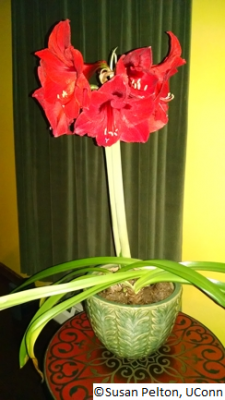This fact sheet is for informational purposes only. If you are in need of immediate assistance regarding poisonous or toxic plants, please consult the National Poison Center at (800) 222-1222 or dial 911.
Many homes contain houseplants or other natural materials to add beauty and interest to the décor. Not only are they attractive but many varieties of houseplants serve as indoor air cleaners as well. Lovely and functional as they may be, some houseplants may present a hazard especially if young children or pets share the household.

A toxic plant is one that contains a chemical substance which produces a harmful reaction in the body of humans or animals when taken in small or moderate amounts. A harmful reaction could include allergic reactions, dermatitis or skin irritation, of internal poisoning. Allergic reactions are not always classified as poisoning and will not be treated as such here. This is because there is a wide range of plants that can cause allergic reactions, and sensitivity to a plant varies among individuals. Also, individuals can react in different ways after contact with a toxic plant depending on their sensitivity level.
It is important that houseplant owners be aware of the potential problems that plants with toxic properties might cause.
- Be aware of the identity of your houseplants and learn if they pose potential threats to children and pets.
- If you cannot identify a houseplant, call your local Extension Center or the Home and Garden Education Center for assistance.
- It is also important to realize that many plants need to be consumed in considerable quantities for poisoning to occur. Often toxic plants taste bitter or acrid and children and pets may not ingest large amounts.
- Young children, especially, should be taught not to put unknown plants or plant parts in their mouths.
- Any plant may cause a reaction in certain people.
- If a plant is eaten, remove the rest from the mouth and rinse the mouth with water.
- If a houseplant or natural decoration is ingested by children or pets and poisoning is suspected, call your family doctor, nearest emergency room or veterinarian immediately.
The following is a list of plants considered toxic.
Remember that plants may contain a variety of poisons. They may cause symptoms ranging from a mild stomach ache to serious heart and kidney problems.
| Common Name | Latin Name |
| Amaryllis | Hippeastrum spp. |
| Anthurium | Anthurium spp. |
| Apricot kernels | Prunus armeniaca |
| Azaleas | Rhododendron spp |
| Caladium | Caladium bicolor |
| Calla Lily | Calla palustrus |
| Chinese Evergreen | Aglaonema spp. |
| Colchicum | Colcicum autumnale |
| Daffodil | Narcissus spp. |
| Dumb Cane | Dieffenbachia spp. |
| Elephant’s Ear | Colocasia antiquorum |
| English Ivy | Hedera helix |
| Fishtail Palm | Caryota spp. |
| Holly Berries | Ilex spp. |
| Hyacinth | Hyacinthus orientalis |
| Jerusalem Cherry | Solanum pseudocapsicum |
| Lantana | Lantana camara |
| Mistletoe | Phoradendron villosum |
| Mountain laurel (holiday greens) |
Kalmia spp. |
| Oleander | Nerium oleander |
| Philodendron | Philodendron spp. |
| Ranunculus | Ranunculus spp. |
| Rosary Pea | Abrus precatorius |
| Schefflera | Schefflera actinophylla |
| Spathiphyllum | Spathiphyllum spp. |
| Yew (holiday greens) | Taxus spp. |
| ZZ Plant | Zamioculcas zamifolia |
Plants listed below are considered safe and not toxic.
Although eating or touching these plants is unlikely to cause illness, any plant might cause a reaction in certain sensitive individuals.
| Common Name | Latin name |
| African daisy | Dimorphotheca aurantiaca |
| African Violet | Saintpaulia ionantha |
| Aluminum Plant | Pilea spp. |
| Baby's Tears | Soleiria soleirolii |
| Bamboo, Golden | Phyllostachys aurea |
| Bird of Paradise | Strelitzia reginae |
| Bird's Nest Fern | Asplenium nidus |
| Boston Fern | Nephrolepis exaltata |
| Camellia | Camellia sinensis |
| Cast Iron Plant | Aspidistra elatior |
| Christmas Cactus | Schlumbergera bridgesii |
| Coleus | Coleus hybridus |
| Corn Plant | Dracaena sp. |
| Donkey's tail | Sedum morganianum |
| Dracaena | Dracaena spp. |
| Echeveria | Echeveria spp. |
| Figs; Weeping & Fiddleleaf** | Ficus spp. |
| Geraniums | Pelargonium spp. |
| Goldfish Plant | Columnea spp. |
| Impatiens | Impatiens wallerana |
| Jade Plant | Crassula argentea |
| Japanese Aralia | Fatsia japonica |
| Kalanchoe | Kalanchoe spp. |
| Lipstick Plant | Aeschynanthus spp. |
| Maidenhair Fern | Adiantum spp. |
| Nerve Plant | Fittonia spp. |
| Orchids | Cattleya, Epidendrum, Oncidium, Paphiopedilum spp. |
| Norfolk Island Pine | Araucaria heterophylla |
| Palms | Palmae (most non-toxic except Fishtail Palm, Caryota spp. ) |
| Peperomia | Peperomia spp. |
| Piggyback plant** | Tolmiea mensziesii |
| Poinsettia** | Euphorbia pulcherrima |
| Prayer Plant | Maranta leuconeura |
| Purple Passion Plant | Gynura aurantiaca |
| Sensitive Plant | Mimosa puddica |
| Surinam Cherry | Eugenia uniflora |
| Swedish Ivy | Plectranthus spp. |
| Wandering Jew | Tradescantia spp. |
| Wax Plant | Hoya carmosa |
| Zebra Plant | Aphelandra squarrosa |
**sap may be irritating.
References:
A Guide to House Plant Poisoning, Prevention and Treatment, University of Utah Health Sciences Center, Salt Lake City Utah, 2000.http://uuhsc.utah.edu/pated/handouts/handout.cfm?id=2167
Barkley, Shelley. Poisonous House Plants, Government of Alberta Canada, 2005. http://www1.agric.gov.ab.ca/$department/deptdocs.nsf/all/webdoc1376
http://www.serenataflowers.com/Poisonous-Flowers-and-Plants
Revised by UConn Home and Garden Education Center 2016.